 [Image: Photo by Satya Pemmaraju, courtesy of the Architectural League].
[Image: Photo by Satya Pemmaraju, courtesy of the Architectural League].Here are some upcoming events, courses, and lectures that I would attend if I could:
—Tonight, March 26, author
William L. Fox speaks in Reno at the
Nevada Museum of Art about his new exhibition, co-curated with Matthew Coolidge of the
Center for Land Use Interpretation, about the
Trans-Alaska Pipeline. Hopefully Fox will also discuss his newest book,
Aereality: The World From Above; Fox's books are an ongoing exploration of "extreme environments" and their impact on human cognition, from Antarctica and the gridless deserts of Nevada to the Australian Outback and even Mars.
—Also today, March 26, kicking off in Los Angeles (and then again four days from now, on March 30, in
Chicago) is an
Urban Escape and Evasion course run by the group
OnPoint Tactical. The premise of this is hilarious but fascinating: "While on an international business trip, you are kidnapped and held for ransom. A terrorist attack closes the business district and you find yourself in a fix. How do you stay alive? How do you get to safety on your own?"
This class provides leading-edge skills to civilians who live and work in challenging urban environments or in urban centers that may destabilize during a crisis. Topics covered include covert movement (day vs. night), the judicious use of caches, understanding urban baseline movement and urban awareness training, the use of urban disguises and false papers/identification, lock picking, escaping from unlawful custody, obtaining and driving local transportation, the use of "specialized" urban gear, and instruction on how to develop urban escape and evasion go-bags, etc.
If you already know how to do all that, of course, there are also
advanced courses. For that, somewhere in the Philadelphia/Camden, NJ, area, beginning April 30, trainees will "spend time in the city in an extensive (extended) escape and evasion simulation. Students will be required to obtain food, water, and shelter. They will need to avoid capture, and they will be required to complete several tests or scenarios that will require advanced students to truly apply their scout and urban survival skills." I love OnPoint's final line: "Warning: Massive waiver required for this course!" These "urban survival" courses are run in Los Angeles, Philadelphia, Chicago, Dallas, Salt Lake City, and Conway, Arkansas. If only I had known about OnPoint earlier, I would have invited them to speak at
Postopolis! LA. Check out their
lock-picking gear. (Spotted via
kottke.org).
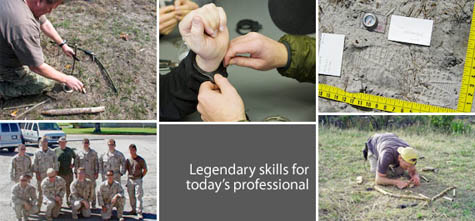 [Image: Think you'll survive a corporate kidnapping (or the coming apocalypse)? OnPoint Tactical disagrees; sign up for their courses to learn more].
[Image: Think you'll survive a corporate kidnapping (or the coming apocalypse)? OnPoint Tactical disagrees; sign up for their courses to learn more].—March 27-29:
The City From Below hits Baltimore, Maryland, exploring, among other things, how "unanticipated futures are being imagined and built" in the contemporary metropolis. My problem with the event write-up, however, is that participating in "social justice struggles" appears to mean adopting a new, niche vocabulary full of analytically useless words like "herstories" – i.e. feminism's own "
Freedom Fries" moment – excluding from your audience many of the very people who would benefit most from such discussions. Emerging forms of grassroots urban self-governance don't require bizarre, over-academized newspeak about "metropolitan rearticulation" and "horizontal framework[s] of participation." We don't need to know that you've read
Judith Butler in order to organize a better youth basketball league, plant a roof garden, or campaign for affordable day care. I also have a growing problem with the fetishization of "resistance" in today's leftwing political writing, as if "resisting" something is, in and of itself, a technique that only the left is capable of performing. But the Bush Administration "resisted" the
Geneva Conventions and
Alberto Gonzales "resisted" civil liberties laws, even as the Mormon Church "resisted"
gay marriage in California. Resistance has no political affiliation, and it is tactically meaningless to promote resistance as a goal in and of itself. One need look no further than the conservative
Counter-Reformation; as its very name indicates, this was a massive act of cultural and intellectual
resistance. Indeed, to pretend that "resistance" is worthy of commendation at all only makes sense if you've built your entire movement around a shifting sequence of enemies who, by your own admission, are always one step ahead of you. The alternative – articulating, out of the blue and in the middle of nowhere, unsolicited enthusiasm for a more equitable future for everyone – would seem both substantially more effective and unifying. It seems little wonder, then, that many otherwise intensely interesting urban social justice movements remain rhetorically self-ghettoized, when their own communication strategies seem to exclude the very people they most urgently need to convince.
—On Monday, March 30, London's
Complex Terrain Laboratory will begin a
four-day symposium about P. W. Singer's important new book
Wired for War (previously mentioned on BLDGBLOG
here). As the event unfolds, regular updates will be posted
online.
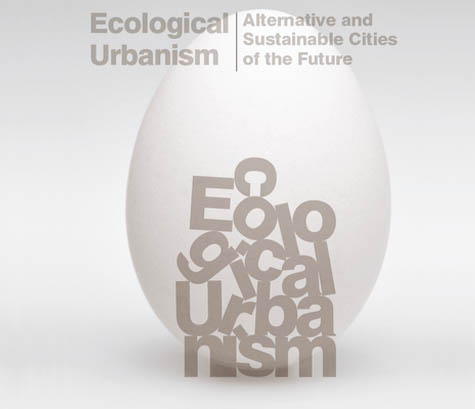 [Image: Ecological Urbanism at the Harvard GSD].
[Image: Ecological Urbanism at the Harvard GSD].—If it wasn't for
Postopolis! LA, I would be in Boston, attending Harvard's
Ecological Urbanism conference, running April 3-5. "While climate change, sustainable architecture, and green technologies have become increasingly topical," we read, "issues surrounding the sustainability of the city are much less developed."
The conference is organized around the premise that an ecological approach is urgently needed both as a remedial device for the contemporary city and an organizing principle for new cities. An ecological urbanism represents a more holistic approach than is generally the case with urbanism today, demanding alternative ways of thinking and designing.
Speakers include – and
the list looks great –
Rem Koolhaas,
Andrea Branzi,
Stefano Boeri,
Anuradha Mathur, and super-dean
Mohsen Mostafavi, among many, many others.
—Saturday, April 4, in Montreal, the excellent
Canadian Centre for Architecture will sponsor
Mapping Rural Montréal: "Artist
Amy Franceschini leads an exploration of rural sites and activities in Montréal, questioning the dichotomy of country and city (in English). $10 per person. Free for children under 12. Reservations required: (514) 939-7026."
—On April 25, Esotouric will be hosting a bus tour of
Raymond Chandler's Los Angeles: "Bungalows. Crime. Hollywood. Blondes. Vets. Smog. Death. This was Raymond Chandler’s Los Angeles, which resonated from deft and melancholy fits of his writer’s bow." Esotouric's
Reyner Banham Loves Los Angeles tour also looks well worth a spin.
—Finally, for now – as there are dozens and dozens of other amazing events I could mention – the
Architectural League in New York is hosting what sounds like an exciting two-day conference called
New Architectures of India, from April 30-May 1. It will "address the architectural and urban forms that are emerging as a turbulent 'second modernity' rearranges a vast part of the landscape of India."
All of these are barely the tip of the iceberg, however; I'll hope to keep track of other lectures, events, gallery openings, conferences, courses, and such like as the year trundles on.
 This past weekend I was able to see a classic cult film, Harold and Maude (1971). While I loved the movie, what really caught my eye was the house of Harold's mother, Mrs. Chasen.
This past weekend I was able to see a classic cult film, Harold and Maude (1971). While I loved the movie, what really caught my eye was the house of Harold's mother, Mrs. Chasen.  The house really reminds me of the work of John Woolf: mainly because of that canopy over the front door. (Read this great article from Vanity Fair about Woolf by Matt Tyrnauer HERE). Classic Woolf, don't you think? From what I could find HERE though, the house is actually the The Rose Court Mansion in Hillsborough and many of the scenes were shot inside, even using the actual butler from the house in the movie!
The house really reminds me of the work of John Woolf: mainly because of that canopy over the front door. (Read this great article from Vanity Fair about Woolf by Matt Tyrnauer HERE). Classic Woolf, don't you think? From what I could find HERE though, the house is actually the The Rose Court Mansion in Hillsborough and many of the scenes were shot inside, even using the actual butler from the house in the movie! The home is extremely eclectic inside, but French styles dominate. This study, seen above was off the main living room where all of the dates Harold takes, set up by his mother, take place.
The home is extremely eclectic inside, but French styles dominate. This study, seen above was off the main living room where all of the dates Harold takes, set up by his mother, take place. 1971....but this could be a home today for the most part, don't you agree? The classic white lenox lamps, the beautiful chair in the background, simple drapes, big windows. I just loved this room!
1971....but this could be a home today for the most part, don't you agree? The classic white lenox lamps, the beautiful chair in the background, simple drapes, big windows. I just loved this room! The classic lenox lamp is used throughout the room as are potted orchids. The couch is a bit dated but still stylish: simple white linen with an interesting trim. My poor pictures don't capture the beautiful painted paneling in this room either.
The classic lenox lamp is used throughout the room as are potted orchids. The couch is a bit dated but still stylish: simple white linen with an interesting trim. My poor pictures don't capture the beautiful painted paneling in this room either. Here you see that chair again...the clothes are definitely dated even if the room is not...
Here you see that chair again...the clothes are definitely dated even if the room is not... I loved the pelmets over the curtains - so perfect for a mansion of this caliber.
I loved the pelmets over the curtains - so perfect for a mansion of this caliber. Yes, the yellow ragweed flowers are dated as is the victorian style table but you catch a better glimpse of the beautiful paneling in this room and the chinoiserie statue. Check out the checked B&W marble tiled hallway! classic!
Yes, the yellow ragweed flowers are dated as is the victorian style table but you catch a better glimpse of the beautiful paneling in this room and the chinoiserie statue. Check out the checked B&W marble tiled hallway! classic! From the next room over, you get a better glimpse of the living room. I love the 2 stylish 20's era portrait as well as the game-table in the corner; Another great white chair as well! Just ignore Harold's fake suicide attempt here in this photo with his feet up in the air.....just like his mother did!
From the next room over, you get a better glimpse of the living room. I love the 2 stylish 20's era portrait as well as the game-table in the corner; Another great white chair as well! Just ignore Harold's fake suicide attempt here in this photo with his feet up in the air.....just like his mother did!

 This past thursday I attended the DC launch party of Barry Dixon's rug collection at Timothy Paul. I had been in the bedding and home store of Timothy Paul up the street but had never been into the carpet showroom so I was excited to see it!
This past thursday I attended the DC launch party of Barry Dixon's rug collection at Timothy Paul. I had been in the bedding and home store of Timothy Paul up the street but had never been into the carpet showroom so I was excited to see it!

 All of the different designs are very personal to Barry, picked up from his travels. Ideas came from pieces of tooled leather picked up in bazaars and the pattern of leaves on a forest floor.
All of the different designs are very personal to Barry, picked up from his travels. Ideas came from pieces of tooled leather picked up in bazaars and the pattern of leaves on a forest floor.



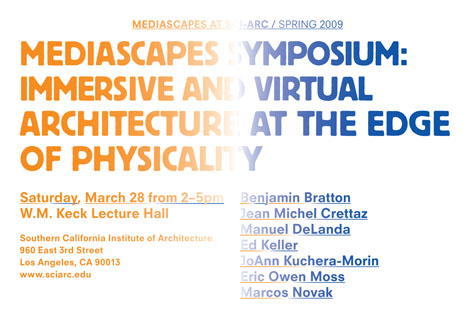 The bulk of the afternoon's discussion will encompass "the practice of immersive and virtual architecture, which spans animation and 3D technologies, digital environments, and questions of materiality... asking how these classifications will define our understanding of the relationships between tangible and intangible worlds."
The bulk of the afternoon's discussion will encompass "the practice of immersive and virtual architecture, which spans animation and 3D technologies, digital environments, and questions of materiality... asking how these classifications will define our understanding of the relationships between tangible and intangible worlds."



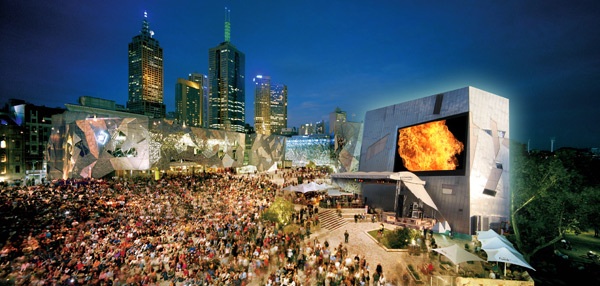 [Image: A rendering of a "media facade" in action, in Melbourne's Federation Square; image via
[Image: A rendering of a "media facade" in action, in Melbourne's Federation Square; image via 








 Leah came over last weekend to check out my place and chat for awhile. She's a great photographer and really captured my apartment well, no easy feat in such a small space! We had so much fun talking it hardly felt like an interview at all!
Leah came over last weekend to check out my place and chat for awhile. She's a great photographer and really captured my apartment well, no easy feat in such a small space! We had so much fun talking it hardly felt like an interview at all!



 [Image:
[Image:  [Image: Photo by Satya Pemmaraju, courtesy of the
[Image: Photo by Satya Pemmaraju, courtesy of the  [Image: Think you'll survive a corporate kidnapping (or the
[Image: Think you'll survive a corporate kidnapping (or the  [Image:
[Image: 


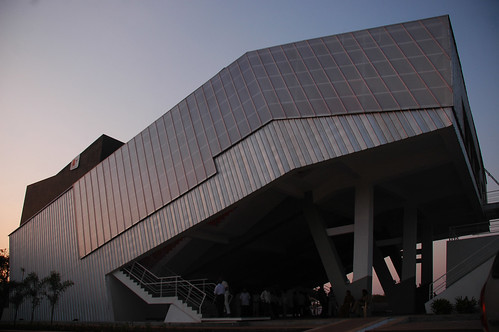


 The architect matched the federal style applied to the structure with this beautiful detailed brickwork. Like elsewhere on the estate, the lanterns are intricate ironwork with delicate leaves and swirls. The french doors must be 8 1/2' tall; Love the transoms too!
The architect matched the federal style applied to the structure with this beautiful detailed brickwork. Like elsewhere on the estate, the lanterns are intricate ironwork with delicate leaves and swirls. The french doors must be 8 1/2' tall; Love the transoms too! Here is a detail of the cornice and one of the transom windows.
Here is a detail of the cornice and one of the transom windows. The interior has a 150 yr old fig tree (vine?) that encompasses the entire room, covering everything. You can see it here above the entrance to the space from the breezeway and how it wraps the entire space below.
The interior has a 150 yr old fig tree (vine?) that encompasses the entire room, covering everything. You can see it here above the entrance to the space from the breezeway and how it wraps the entire space below. So lush and green, the same hexagonal clay tiles are on the floor.
So lush and green, the same hexagonal clay tiles are on the floor.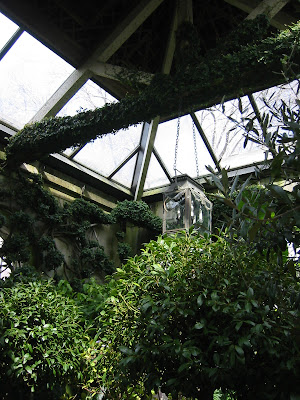 The lanterns are almost hidden behind all the plants. The way an orangery should be!
The lanterns are almost hidden behind all the plants. The way an orangery should be!
 Each wall between french doors & transoms has a beautiful medallion or plaque. I love the way the fig tree has grown around them.
Each wall between french doors & transoms has a beautiful medallion or plaque. I love the way the fig tree has grown around them.